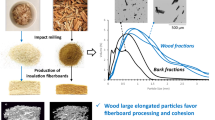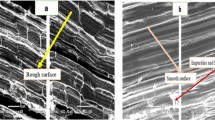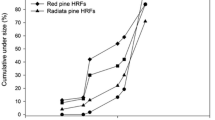Abstract
Natural fibers, known for their accessibility and biodegradability, have been explored as alternatives in fiberboard production. This research focuses on harnessing pineapple leaves for crafting paper and fiberboard sheets. Three classifications of pineapple leaves underwent NaOH treatment (ranging from 0.5 to 2%) to facilitate paper production. Optimal NaOH concentrations were determined to be 2% for dried pineapple leaves, 0.5% for fresh pineapple leaves, and 0.5% for a mix of fresh pineapple leaves and straw. In the context of fiberboard sheets, thicknesses were standardized using an extrusion force of 8 kef/cm2, resulting in 6, 9, and 12 mm variants. Flexural strength, tested in line with ASTM C293, peaked at 15.120 MPa for the 12 mm variant. Notably, water absorption capability improved by 65% when using the 12 mm pineapple leaf fiberboard. The observed thermal conductivity of this fiberboard lay between 0.03957 and 0.04295 W/m.K, denoting low thermal conductivity. These findings pave the way for the production of fiberboards tailored for residential constructions and energy-efficient applications, capitalizing on agricultural byproducts.









Similar content being viewed by others
Data availability
The datasets generated during and/or analyzed during the current study are available from the corresponding author on reasonable request.
References
Haque F, Fan C, Lee Y-Y (2023) From waste to value: addressing the relevance of waste recovery to agricultural sector in line with circular economy. J Cleaner Prod 415:137873
United Nations, Department of Economic and Social Affairs, Population Division (2022) World population prospects 2022: highlights. https://population.un.org/wpp/
Aili Hamzah AF, Hamzah MH, Che Man H, Jamali NS, Siajam SI, Ismail MH (2021) Recent updates on the conversion of pineapple waste (Ananas comosus) to value-added products, future perspectives and challenges. Agronomy 11(11):2221
Madurwar MV, Ralegaonkar RV, Mandavgane SA (2013) Application of ago-waste for sustainable construction materials: a review. Constr Build Mater 38:872–878
Ardanuy M, Claramunt J, Toledo Filho RD (2015) Cellulosic fiber reinforced cement-based composites: a review of recent research. Constr Build Mater 79:115–128
Nasir M, Khali DP, Jawaid M, Tahir PM, Siakeng R, Asim M, Khan TA (2019) Recent development in binder less fiber-board fabrication from agricultural residues: a review. Constr Build Mater 211:502–516
Chen RS, Ahmad S (2021) Extrusion processing of a high fiber loading of agrowaste in recycled polyolefin biocomposite. J Thermoplast Compos Mater 34(1):40–54
Thailand FIC (2015) Pineapple industry. National food Institute, Bangkok
Jirapornvaree I, Suppadit T, Popan A (2017) Use of pineapple waste for production of decomposable pots. Int J Recycl Organic Waste Agric 6:345–350
Nath PC, Ojha A, Debnath S, Neetu K, Bardhan S, Mitra P, Sharma M, Sridhar K, Nayak PK (2023) Recent advances in valorization of pineapple (Ananas comosus) processing waste and by-products: A step towards circular bioeconomy. Trends Food Sci Technol 136:100–111
Nasution FM (2021) Manufacture and Characterization of Pineapple Leaf Fiber Composite Board with Polypropylene Adhesive. Jurnal Matematika Dan Ilmu Pengetahuan Alam LLDikti Wilayah 1 (JUMPA) 1(1):15–19
Mund NK, Dash D, Mishra P, Nayak NR (2021) Cellulose solvent-based pretreatment and enzymatic hydrolysis of pineapple leaf waste biomass for efficient release of glucose towards biofuel production. Biomass Convers Biorefin, pp 1–10
Baskaran M, Hashim R, Sulaiman O, Hiziroglu S, Sato M, Sugimoto T (2015) Optimization of press temperature and time for binderless particleboard manufactured from oil palm trunk biomass at different thickness levels. Mater Today Commun 3:87–95
Ab Ghani MH, Royan NRR, Kang SW, Sulong AB, Ahmad S (2015) Effect of alkaline treated rice husk on the mechanical and morphological properties of recycled HDPE/RH Composite. J Appl Sci Agric 10(5):138–144
Abou-Kandil AI, Shehata AB, Yousef E, El-Sabbagh I, Salem K (2017) Effect of microstructural changes on thermal, electrical, and mechanical properties of HDPE reinforced by sisal fibers. J Thermoplast Compos Mater 30(10):1373–1392
Wong KJ, Yousif BF, Low KO (2010) The effects of alkali treatment on the interfacial adhesion of bamboo fibres. Proc Inst Mech Eng Part L J Mater Des Appl 224(3):139–148
Yiga VA, Lubwama M, Olupot PW (2023) Thermal stability of NaOH modified rice husk fiber-reinforced polylactic acid composites: effect of rice husks and clay loading. Results Mater 18:100398
Muthuraj R, Lacoste C, Lacroix P, Bergeret A (2019) Sustainable thermal insulation biocomposites from rice husk, wheat husk, wood fibers and textile waste fibers: Elaboration and performances evaluation. Ind Crops Prod 135:238–245
Wei J, Meyer C (2015) Degradation mechanisms of natural fiber in the matrix of cement composites. Cem Concr Res 73:1–16
Wei J, Ma S, D’Shawn GT (2016) Correlation between hydration of cement and durability of natural fiber-reinforced cement composites. Corros Sci 106:1–15
Guna V, Ilangovan M, Hu C, Venkatesh K, Reddy N (2019) Valorization of sugarcane bagasse by developing completely biodegradable composites for industrial applications. Ind Crops Prod 131:25–31
Arman NSN, Chen RS, Ahmad S (2021) Review of state-of-the-art studies on the water absorption capacity of agricultural fiber-reinforced polymer composites for sustainable construction. Constr Build Mater 302:124174
Karthik S, Arunachalam VP (2020) Investigation on the tensile and flexural behavior of coconut inflorescence fiber reinforced unsaturated polyester resin composites. Mater Re Express 7(1):015345
Ferrández-García CC, Ferrández-García CE, Ferrández-Villena M, Ferrandez-García MT, García-Ortuño T (2017) Acoustic and thermal evaluation of palm panels as building material. BioResources 12(4):8047–8057
Muthuraj R, Grohens Y, Seantier B (2017) Mechanical and thermal insulation properties of elium acrylic resin/cellulose nanofiber based composite aerogels. Nano-Struct Nano-Objects 12:68–76
Lacoste C, El Hage R, Bergeret A, Corn S, Lacroix P (2018) Sodium alginate adhesives as binders in wood fibers/textile waste fibers biocomposites for building insulation. Carbohyd Polym 184:1–8
Hýsek Š, Podlena M, Bartsch H, Wenderdel C, Böhm M (2018) Effect of wheat husk surface pre-treatment on the properties of husk-based composite materials. Ind Crops Prod 125:105–113
Mawardi I, Aprilia S, Faisal M, Rizal S (2022) An investigation of thermal conductivity and sound absorption from binderless panels made of oil palm wood as bio-insulation materials. Results Eng 13:100319
Yang HS, Kim DJ, Kim HJ (2003) Rice straw–wood particle composite for sound absorbing wooden construction materials. Biores Technol 86(2):117–121
Nandanwar A, Kiran MC, Varadarajulu KC (2017) Influence of density on sound absorption coefficient of fibre board. Open J Acoust 7(01):1
Bhingare NH, Prakash S, Jatti VS (2019) A review on natural and waste material composite as acoustic material. Polym Test 80:106142
Bubparenu N, Laemsak N, Chitaree R, Sihabut T (2018) Effect of density and surface finishing on sound absorption of oil palm frond. Asia-Pacific J Sci Technol 23(4):1–7
Akinyemi AB, Afolayan JO, Oluwatobi EO (2016) Some properties of composite corn cob and sawdust particle boards. Constr Build Mater 127:436–441
Koul B, Yakoob M, Shah MP (2022) Agricultural waste management strategies for environmental sustainability. Environ Res 206:112285
Hassan MK (2017) Characterization of face sheet/core debonding strength in sandwiched medium density fiberboard. Mater Sci Appl 8(9):673–684
Connolly B (2016) A contribution to understanding the mass and heat transfer through the building envelope components (Doctoral dissertation, North Carolina Agricultural and Technical State University)
Shimamoto D, Tominaga Y, Imai Y, Hotta Y (2016) Fiber orientation and flexural properties of short carbon fiber/epoxy composites. J Ceram Soc Jpn 124(1):125–128
Senthilkumar K, Rajini N, Saba N, Chandrasekar M, Jawaid M, Siengchin S (2019) Effect of alkali treatment on mechanical and morphological properties of pineapple leaf fibre/polyester composites. J Polym Environ 27:1191–1201
Lu D, Xiong X, Lu G, Gui C, Pang X (2023) Effects of NaOH/H2O2/Na2SiO3 bleaching pretreatment method on wood dyeing properties. Coatings 13(2):233
Tavares KM, de Campos A, Mitsuyuki MC, Luchesi BR, Marconcini JM (2019) Corn and cassava starch with carboxymethyl cellulose films and its mechanical and hydrophobic properties. Carbohyd Polym 223:115055
Motaleb KZMA, Islam MS, Hoque MB (2018) Improvement of Physicomechanical Properties of Pineapple Leaf Fiber Reinforced Composite. Int J Biomat 2018:7384360. https://doi.org/10.1155/2018/7384360
Acknowledgements
The authors would like to thank the faculty of agriculture and the faculty of architecture, Rajamangala University of Technology Srivijaya. The authors thank the Center of Building Innovation and Technology, faculty of architecture, Kasetsart University.
Funding
This research was supported by Grant No. 005/2566, Fundamental Fund, Thailand Science Research and Innovation.
Author information
Authors and Affiliations
Contributions
All authors contributed equally.
Corresponding author
Ethics declarations
Conflict of interest
There is no competing interests between authors. All authors agree to publish the manuscript.
Ethical statement
In conducting this research, no human participants or animals were directly engaged or subjected to any experimental procedures.
Additional information
Publisher's Note
Springer Nature remains neutral with regard to jurisdictional claims in published maps and institutional affiliations.
Rights and permissions
Springer Nature or its licensor (e.g. a society or other partner) holds exclusive rights to this article under a publishing agreement with the author(s) or other rightsholder(s); author self-archiving of the accepted manuscript version of this article is solely governed by the terms of such publishing agreement and applicable law.
About this article
Cite this article
Morasilp, D., Sangkakool, T. Process optimization and material characterization of fiberboards produced from pineapple leaf waste. J Mater Cycles Waste Manag 26, 1480–1489 (2024). https://doi.org/10.1007/s10163-024-01899-6
Received:
Accepted:
Published:
Issue Date:
DOI: https://doi.org/10.1007/s10163-024-01899-6




